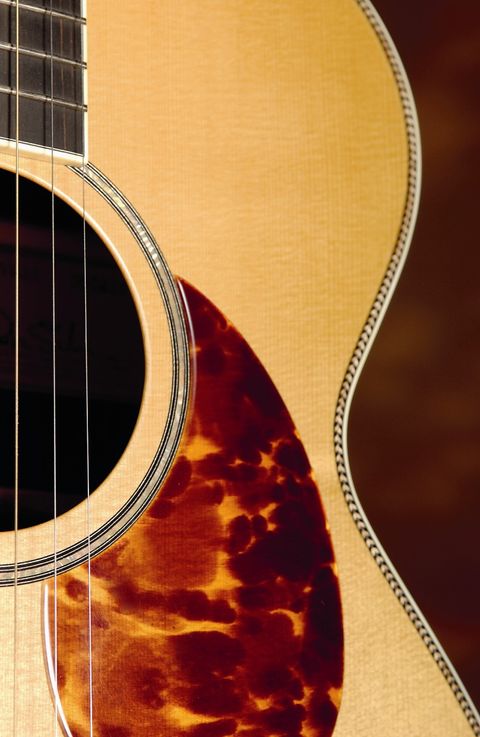Perusing Mr Eggle´s super-clean internal and external workmanship immediately tells us he fully appreciates and complies with the punishing standards set by today´s finest acoustic makers.
Soundboard bracing is a black art, and each maker has their own method to create the voicing they want for a particular model. The Linville´s pattern follows a pre-war Martin layout, but uses slightly wider scalloped struts than usual. Also, the lower of the two lower bout tone bars is particularly radically scalloped - the result of post assembly tone tweaking by its maker. It highlights the kind of individual attention these guitars receive.
The design
This review model´s very subtly tobacco sunburst tinted top is an upgrade, while its remarkably straight grain, with light-catching visual texture, is pure natural beauty. Technically, the abalone in the sound hole rosette is also an upgrade, but its five-ply black/white fibre purfling is standard, as is the optional herringbone perimeter. And while the purfling cuts very clean lines, we could nit-pick about minor imperfections in the abalone inlay.
Tor-Tis scratchplates like this one offer an authentic reproduction, in both their colour and pattern, of the thick celluloid ones found on vintage acoustics. While the sides get no edging at all, the back´s central seam features the classic ‘old Style 28´ black/white zigzag wood marquetry strip.
The one-piece neck is bolted on using a dry mortise/tenon joint method, which is becoming increasingly common in high-end lutherie. Only the fingerboard extension is actually glued. Not only does this simplify any future neck resets, but many luthiers believe you also achieve superior wood-to-wood contact compared to a traditional dovetail.
Eggle doesn´t use an L-shaped neck block, but the upper bout is supported by the usual horizontal brace just above the soundhole and, above that, a very thick spruce pad, which is also utilised during the fretting process.
The Martin-style headstock features the traditional carved dart at its rear base, while its vibrantly grained Brazilian rosewood face carries an inlaid mother-of-pearl logo and ivoroid binding (another slight upgrade). These Waverly tuners look the part, and have smooth, solid mechanisms. Fingerboard and frets are beautifully finished and presented, although if you get the magnifying glass out you´ll spot some gaps in the inlay filler.
The expertly fitted nut and saddle are both cut from unbleached bone, and so have that naturally murky, translucent off cream look you find on vintage acoustics. Traditional and neatly finished, the bridge carries a set of abalone-dotted ebony pins. In keeping with the territory, we have a clear nitrocellulose lacquer finish that´s perfectly even and judiciously lightly coated, with the neck finished separately for a clean join.
The Linville neck may share Martin´s standard OM nut width but, with its modified ‘C´-profile shaft only 20mm (first fret) to 22mm (10th fret) deep and a couple of millimetres narrower at the octave, it feels noticeably slighter in the hand. Its optimal string spacing delivers plenty of breathing room. As its appearance suggests, the fingerboard is perfectly silky and its gleaming frets are flawlessly trimmed. We´ve mentioned that new nitrocellulose finishes can feel a bit sticky for some players, but Eggle considers this phenomenon a temporary quirk of this notoriously slow curing lacquer.
In use
This review model has arrived with an enticingly ‘light and low´ set-up that takes all the strain out of even the most demanding manoeuvres, although it´s a bit floppy for hard plectrum playing. The fact there´s no choking out is testament to an incredibly even fingerboard and uniform fret height. Saddle clearance, however, remains very healthy since the neck is pitched fractionally further back than on many acoustics; and yet the way Eggle fits neck/fingerboard to body results in minimal ‘hinging´ and ‘falling off´ of the fingerboard from the body joint onwards. Intonation at the 12th is as tuneful as a non-compensated saddle can achieve; and for the kind of usage this guitar invites, it´s not an issue.
As a popular steel-string type for fingerstyle, the ideal tonal qualities for an OM are not dissimilar to those of a good classical guitar. We´re listening out for excellent string separation; a relatively unbiased balance across the frequencies, while retaining depth, richness and warmth at the heart of the sound; presence and clarity, married with a sweet chiming treble voice; and plenty of even-toned volume rather than the dreadnought boom. We want a responsive instrument that tracks the fine nuances of your playing, and one that doesn´t require too much effort to get going.
Obviously that´s what Patrick Eggle thinks too, because that´s pretty much the profile of the Linville. Like a diplomat with impeccable social manners it is gracefully articulate and adept at putting you at ease with its silver-tongued delivery. Breathing fresh life into even your most well-worn old party pieces, the Linville runs your repertoire through a magical musical makeover; sympathetically conveying even the most subtle moments of your performance, so everything sounds more focused and emotionally intact. However, the Linville is no wallflower either.
Even with this review guitar´s dynamically restrictive string height, its sound is thick enough to endure much harder playing. And it is this marriage of crisp lucidity and satisfyingly solid tones that produces the Linville´s rare, and welcome, ‘straight from the case´ maturity.
If you want our advice, catch PJEG acoustics while this brand is still in its infancy and the prices are reasonable, because we would not be surprised if the reputation of, and demand for, these instruments follows a swift upward spiral. Please note, however, our quoted Eggle list prices are direct dollar conversions and do not include UK shipping/duty and VAT.


